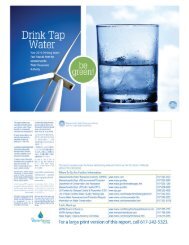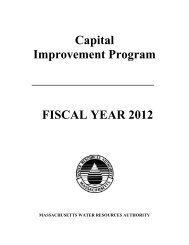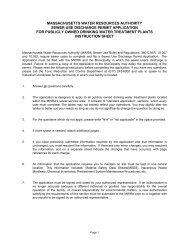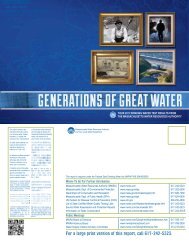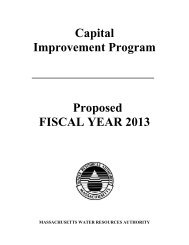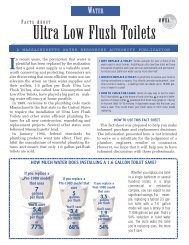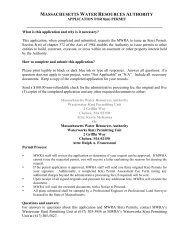Quarter 2 - Massachusetts Water Resources Authority
Quarter 2 - Massachusetts Water Resources Authority
Quarter 2 - Massachusetts Water Resources Authority
- No tags were found...
You also want an ePaper? Increase the reach of your titles
YUMPU automatically turns print PDFs into web optimized ePapers that Google loves.
Deer Island Operations2nd <strong>Quarter</strong> - FY13Page 3 of 3Deer Island Operations & Maintenance Report (continued)Environmental/Pumping (continued):A couple of 365-day flow records were broken this quarter including a record lowest 365-day total flow in history (for data evaluated since2000); a total 108.4 billion gallons of flow was treated by DITP from December 1, 2011 through November 30, 2012. The previousrecord low was 118.6 billion gallons of flow from December 1, 2001 through November 30, 2002. Also, December's 267.7 MGD Dry DayFlow is the lowest 365-Dry Day Flow in the history of the new NPDES Permit (1999). The previous 365-Dry Day Flow record of 277.0MGD was recently set in November and before this was 279.6 MGD from April 2011.Residuals Treatment:All four digesters in Module #1 were returned to operation during the middle of November after having been offline since October 2008.The Module #1 digesters were offline while significant piping and valve repair and replacement work was being performed under MWRAContract 7055: Piping and Valve Replacement Project. Once these digesters were in operation, the three active digesters in Module #3were taken offline. The Module #3 digesters will be offline for a period of four to six weeks to undergo maintenance that includesinstalling level sensors in the overflow box in the digesters, gas valves that would allow for the ability to remotely isolate the digesters,and overlow flushing water lines in each digester. Going forward, DITP will operate at steady state using eight active digesters whenpossible.Odor Control:Airflow Fan #14, which draws process air from the South System Pump Station (SSPS) for odor control treatment in the West OdorControl (WOC) Facility, experienced an unanticipated catastrophic failure on July 17, 2012. The nature of this fan failure raised concernsabout the integrity of the remaining fans in this facility, as well as with the fans in the East Odor Control (EOC) Facility which are ofsimilar design and setup. Additional safety procedures restricting personnel from the area while the fans are in operation weretemporarily implemented pending the outcome of detailed inspections and investigation into the possible cause of the failure.Facility-wide shutdowns were scheduled in both the WOC and EOC Facilities in <strong>Quarter</strong> 2 to remove and replace the failed fan and toperform various essential maintenance activities such as fan impeller cleaning and replacing activated carbon in the carbon adsorberunits. The initial inspection of the fans in the WOC Facility was done in conjunction with the fan manufacturer and the inspections foundall the fans in both facilities to be in good condition. By November, after careful review of all the inspections and evaluations from theinvestigation, odor control airflow fans were allowed to remain in operation while workers are within the facility as there was noindications of risk.Hydrogen peroxide was added to the influent wastewater during these shutdowns to reduce the level of the odor causing hydrogensulfide in the wastewater. No odor complaints were received during these shutdowns. Planned shutdowns in the WOC, EOC, andNPOC Facilities were documented in the <strong>Quarter</strong>ly Non-combustion Emissions Report as required by the Air Quality Operating Permitissued to DITP by the <strong>Massachusetts</strong> Department of Environmental Protection (MaDEP).Energy and Thermal Power Plant:Solar Power generation was 1.3% (average of 42,841 kwh) and Wind Turbine generation was 4.86% (average of 162,801 kwh) of thetotal power generated on-site for the 2nd <strong>Quarter</strong>. Solar power generation includes solar installations on the roof of the Residuals OdorControl (ROC) Facility, Maintenance/Warehouse (M/W), and the Grit Facility buildings, in addition to the solar installation on the groundof the South Parking Lot. Wind Turbine power generation includes generation by the two wind turbines located in the South Parking Lotand intermittent generation during optimization and testing by the FloDesign wind turbine installed near the Hydro Power Plant.Overall, total power generated on-site accounted for 26.8% of Deer Island's total power use for the 2nd <strong>Quarter</strong> of FY13.The primary Steam Turbine Generator (STG) was taken offline for 10 days in November during the Thermal Power Plant's annualmaintenance. The maintenance on the BP STG took place from November 11 to November 13 at which time both STGs were offline atthe same time. The final week of the Thermal Power Plant's annual maintenance was completed in early December and includedcombustion testing and boiler tuning on both Zurn boilers. The boiler combustion testing required each boiler to be tested at variousloads while using digester gas, fuel oil, and a combination of both. The boilers performed within expectations during the combustiontesting.Regulatory:Based on preliminary December data, Deer Island should qualify to receive NACWA’s (National Association of Clean <strong>Water</strong> Agencies)Platinum Award for Peak Performance which recognizes member agency facilities for outstanding compliance of their National PollutantDischarge Elimination System (NPDES) permit limits. The Platinum award is given to agencies in recognition of 100% compliance withNPDES permits over a consecutive five year period. Preliminarily, Deer Island would qualify for its second consecutive Platinum Awardfor having operated with no permit violations from 2007 through 2012. Deer Island’s last permit violation occurred in August 2006.Clinton AWWTP:The construction contract for the fine bubble diffused air system is progressing as scheduled. MWRA has accepted the diffused airsystem, and it is operational. Pump integration control between the new submersibles and the existing internal lift (screw) pumps isplanned for January 2013. This will involve setting the float controller elevations to coordinate with the ultrasonic signals to thesubmersibles and testing system integration/control in the SCADA system.The training of plant staff on the associated equipment and controls has been completed with the exception of a final training session onSCADA. This session will be completed after the system has been in use for a period of time and staff becomes more familiar with it. Theplant will receive an NGRID energy grant for MWRA for approximately $177,000.3




